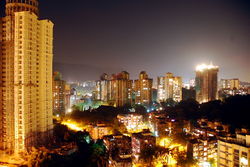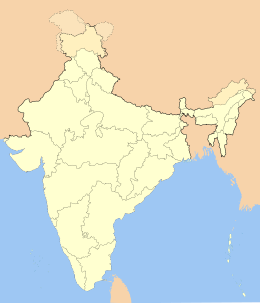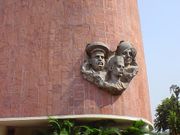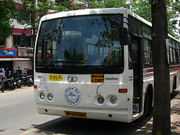Thane
| ठाणे Thane | |
| — suburb — | |
 |
|

ठाणे Thane
in Mumbai ठाणे |
|
| Coordinates | |
| Country | |
| State | Maharashtra |
| District(s) | Thane |
| Mayor | Ashok Vaity |
| Municipal Commissioner | R. Rajeev |
| Parliamentary constituency | Thane |
| Assembly constituency | Thane |
| Population • Density |
1,261,517 (2001[update]) • 8,582 /km2 (22,227 /sq mi) |
| Time zone | IST (UTC+5:30) |
| Area | 147 square kilometres (57 sq mi) |
| Website | www.thane.nic.in |
Thane (Marathi : ठाणे), (also called Thana) is a city in Maharashtra, India, part of the Mumbai Metropolitan Region, northeastern suburb of Mumbai at the head of the Thane Creek. It is the administrative headquarters of Thane District. The city has an area of 147 km2. It had a population of 1.26 million according to the 2001 census.[1]
Contents |
Geography
Thane is located on Salsette Island to the Northeast of Mumbai. Spanning an area of about 147 km², the city is located at an elevation of 7 meters above sea level. It is surrounded by scenic hills, the hill of Yeoor and Parsik Hill. It is divided by Thane Creek, a stream of water from the Ulhas river and Arabian Sea forming an estuary. Two road bridges & one rail bridge connect the two parts of the city.It is one of the oldest cities of India with its history dating back to about 2000 years.
The city has around 30 lakes. The most beautiful of them is the Masunda Talao, also known as Talao Pali. The lake offers boating and water scooter facilities. The Upvan Lake is located at the foot-hills of Yeoor hills and is a scenic spot. It is flanked by the Yeoor hills on one side and the tall Neelkanth Heights on one side. It is a common spot for people to hang out and refresh themselves. Other lakes include :
- Masunda Lake
- Kachrali Lake
- Makhmali Lake
- Ambe Ghonsali Lake
- Siddheshwar Lake
- Jail Lake
- Wagle Lake
- Upvan Lake
Upvan Lake
- Yashasvi Nagar Lake
- Kausa Lake
- Kharegaon Lake
- Raila Devi Lake
- Balkum Lake
- Rewale Lake
- Bramhala-Kolbad Lake
Demographics and culture
In 1825, when the British explored their newly annexed territories in Bassein, they discovered that Thane was inhabited primarily by Roman Catholics, both natives and Portuguese, and that the latter was virtually from the former, both with regards to skin color and custom. The indigenous Catholics were converts from the Bhandaris (musicians) and Koli (fishermen) classes.[2] To this day, some of the upper class East Indians (ethnic group) families in the Khatri ward of Thana speak Portuguese.[3]
At present, Thane has a predominantly Maharashtrian culture although, like its neighbouring city Mumbai, it has a cosmopolitan culture as well. Because of the huge residential boom, the city has witnessed a large number of immigrants from the neighboring city of Mumbai as well as from other pockets of state and country. The face of the city, now a days becoming increasingly cosmopolitan. Beside Marathi, sizeable populations of North Indians, South Indians, Sindhis, Gujaratis and Marwari and other people from different regions live in Thane, mainly because of its proximity to Mumbai.Thane is bordered by the Yeoor Hills on one side and is dotted with numerous beautiful lakes, which are a cause of cooler weather than that of Mumbai.
Festivals such as Ganesh Chaturthi, Navratri and Durga Puja are celebrated with great zest in the city. As in Mumbai, Thane offers high rewards amounting to 1 million rupees (US$ 25,000) for winners of Dahi Handi sport during the Gokulashtami festival.
Since 2005 the Dahi Handi festival has been on a much larger scale; there is competition between various clubs to host the biggest of Dahi Handis. The biggest ones are Open House, Panchpakhdi, Jambli Naka, Tembhi Naka and Vartak Nagar all of these now have TV coverage will almost all major news channels beaming the day's proceedings to the whole nation.

Thane - Brief History
Throughout recorded history the city has left its mark under various names. The earlist evidence of Thane appears in the works of the Greek geographer, ptolemy, who, in his writings ( 135 - 150 AD) refers to a place called Chersonesus, which, according to researches, is the area around Thane creek. The city crops up again in the Middle Ages and slabs and copper plates dating back to the period have been discovered in Thane. One of them, dug up from the foundations of Thane Fort in 1787, dated 1078 AD, is apparently a land grant from Arikesara Devaraja, sovereign of the city of Tagara, wherein he address the inhabitants of a city called Sri Sthanaka. Friar Jordanus, a great traveller, who visited the city between AD 1321 and 1324, describes it as being under a Muslim governer. He leaves a detailed sketch of early Christians in Thane and refers to the martyrdom of four Christian priests in the region, more than 200 years before the Portuguese ever set foot in India. The celebrated Ibn Batuta and Abul Feda, contemporaries of Friar Jordanus, also came here. They refer to Thane as Kukin Tana and speak of its fame as a port from which ships sailed to the gulf carrying a kind of cloth called 'Tanasi' which was produced in Thane. Duarte Barbosa, a noted traveller, described Thane by the name Tana Mayambu 25 years before the portuguese conquest. He paints a vivid picture of the town as one of Moorish mosques and temples, with many pleasant gardens. The portuguese came to Thane about 1530 and ruled for over 200 years till 1739. Thane was then known as Cacabe de Tana. Work on the Thane Fort began in 1730. The Marathas, who conquered Bassein and Thane in 1737 and 1739, held sway over the region till 1784, when the British captured thr Fort and ruled Thane, then also called Tana. They made it the headquarters of the district administration with a district collector stationed in Thane. The Thane Muncipal Council was formed in 1863 when the city had a population of 9000 souls.
For Nature Lovers
Yeour hills is definitely recommended for those with affinity for nature and who desire to seek piece of mind for the weekends. It is a part of Sanjay Gandhi National Park. A visit to the Swami's Math is a must for those seeking peace. If you are lucky, you might get to see a few wild animals, and if you are not maybe a few wild human beings. But a visit after dark has a high probability of attracting both.
Tikujiniwadi is more domesticated wilderness. For a nominal sum, you could spend the entire day including good feast at the in-house restaurant and an execellent siesta on the khat or the satranji (for which you pay of course) under the trees.
Eating Out
Thane has a large number restaurents located in all the various parts of the city. At Ghodbunder road, you can find some of the finest restaurents in the city like Navras, Ambrosia, Courtyard. Although away from the main city, these resaturents have lately started attracting people from the heart of the city who seek an escape from the city during the weekends. They are hugely popular with the young crowd. Apart from Ghodbunder Road, you can find many classic restaurents in the heart of the city such as Barbecue Nation, Moni's, Mantraa, Namaskar, Satkar, Pizza Hut, Dominos etc.
Transport

Thane was the terminus for the first ever passenger train in India. On 16 April 1853, the first passenger train service was inaugurated between Bori Bunder (Now renamed Chatrapati Shivaji Terminus), Mumbai and Thane.[4] Covering a distance of 34 kilometres (21 mi), it was hauled by three locomotives, Sahib, Sindh and Sultan.
Thane is well connected with neighbouring suburbs through Central Railways's sub-urban railway network. There are 4 railway stations in Thane city limit. Thane station is part of the Central Railway division of Indian railways, and is about 34 km away from the Mumbai city station. The other 3 stations are Kalwa, Mumbra, Diva which are also the suburbs of Thane.
Thane has gained new importance as a railway link to Navi Mumbai due to the Thane-Vashi/Nerul and Thane -Panvel local train line.Since Feb2010 new fast trains have started between Thane Panvel- Stopping at KoparKahirane,Neral,Belapur. This line runs many trains between Thane and Vashi, the principal node of Navi Mumbai, passing through Airoli, Ghansoli, Koparkhairane, Turbhe and Sanpada. Almost all trains going to Konkan railway from Mumbai have stops at Thane.
Thane Municipal Transport (TMT), Brihanmumbai Electric Supply and Transport (BEST) , Navi Mumbai Municipal Transport (NMMT), Kalyan Dombivli Municipal Transport (KDMT), Mira-Bhayandar Municipal Transport (MBMT) and MSRTC (State Transport) corporations provide public bus service to the city. Autorickshaw on Meter is available to travel within City along with Taxies Normal as well as A/c.
A light rail network covering 42 km has been proposed in three phases. In the first phase, consultants have suggested connectivity between Balkum and Kolshet via Naupada. It will be 16.05 km long with 14.65 km elevated, and only 1.4 km on the surface, and 11 stations in all.[5]
"The public transport on newly developed Ghodbunder road area is not satisfactory at the moment and needs lot of improvement .The newly constructed SATIS (Station area transport improvement system.)has however given good results" (May 2010).
See also
- Patlipada
- Hiranandani Estate
- Kaasar Vadavali
- Waghbil
- Brahmand
References
- ↑ Thane Municipal Corporation
- ↑ Faces of Goa: a journey through the history and cultural revolution of Goa and other communities influenced by the Portuguese, Karin Larsen, Gyan Books, 1998, p.475
- ↑ Thane Gazzetter: Ppolation: Christians - Speech
- ↑ Colonialism: An International, Social, Cultural and Political encyclopedia By Melvin Eugene Page, Penny M. Sonnenburg, page 135
- ↑ Now, attention on Thane light rail
External links
- Thane travel guide from Wikitravel
| Thane | ||||
| Next station south: Mulund |
Mumbai suburban railway : Central Railway | Next station north: Kalwa |
||
| Stop No: 19 | KM from starting: 34 | Platforms: 10 | ||
|
|||||
|
|||||||||||||||||||||||||||||||||||
|
|||||||||||||||||||||||